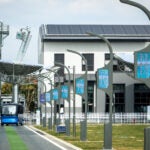Fine grain Optical Transport Network (fgOTN) technology is optimal for future electric power communication networks. Developed under highly regarded international standards, fgOTN addresses limitations in traditional communication network systems by efficiently handling small-bandwidth services while providing high reliability and low latency.
The global electric power industry is undergoing a remarkable transformation through the deployment of impressive digital and intelligent technology. Improving communication networks is important to this process.
As the digital and intelligent infrastructure of electric power, communication networks are the basis for automatic power grid dispatching, market-oriented network operations, and modern management. These systems help to ensure secure, stable, and economical operations of power grids. Electric power communication networks must be highly reliable, evolvable, and efficient to carry existing power production services and future intelligent services.

To enhance the carrying capacity of the communication networks, many global electric power companies have chosen to collaborate with ICT service providers to gain insights into the development trends of electric power services, and have leveraged the providers’ expertise in the optical communications field to develop solutions tailored to the needs of the power industry. One such innovation involves fine grain Optical Transport Network (fgOTN) technology. Based on next-generation communication network standards, fgOTN aims to help the electric power industry overcome challenges and accelerate digital and intelligent transformation.
The electric power industry’s digital and intelligent transformation requires electric power communication networks to carry production network services—including tele-protection, dispatch phone, and security and stability control systems—to ensure high reliability and deterministic low latency of production networks. In addition, service interfaces as well as configuration and maintenance practices must be kept unchanged to reduce migration difficulties and operating expenses (OPEX). Moreover, in the future, electric power communication networks must carry various intelligent services such as situational awareness and IoT data to ensure that service bandwidth can meet intelligence requirements and improve service bearing flexibility.
Innovation Abounds
fgOTN is a relatively new protocol developed under International Telecommunication Union Telecommunication Standardization Sector (ITU-T) standards. Because of these standards, fgOTN will be the mainstream technology in the future. It extends traditional OTN capabilities, allowing systems to efficiently handle small-granularity services, especially those less than 1 Gigabit per second (Gbps), while providing high bandwidth, low latency, physical isolation, and reliability.
The fgOTN design addresses limitations in traditional OTN and SDH (synchronous digital hierarchy) systems, which are prevalent in backbone and metro networks but lack efficiency for low-bandwidth services and struggle with complex and costly operations. Unlike conventional OTN, which requires a minimum 1.25 Gbps for cross-connections, fgOTN supports smaller service sizes with higher precision. Its physical isolation and low-jitter capabilities are beneficial for latency-sensitive applications, such as tele-protection and high-security transmissions. Meanwhile, fgOTN has emerged as the main technology utilized for SDH network upgrades.
fgOTN Applications and Standards
In the electric power industry, a large number of private lines are required to meet the needs of production services. In most cases, production service private lines allow less than 1G bandwidth, but have extremely high requirements on latency and jitter. In addition, hard pipe features such as exclusive bandwidth should be supported for the private lines. As such, SDH and MSTP (multi-service transport platform) technologies are widely used to carry private line services in the electric power industry. However, the SDH/MSTP industry is gradually shrinking, calling for a new technology to carry the high-performance private line services. fgOTN fits the business scenarios of the power industry with features such as low latency, high reliability, and hard isolation.
Transport networks in the electric power industry involve data transmission and power grid control that span power generation, transmission, transformation, distribution, consumption, and dispatching. Additionally, the networks support substation digitalization, dispatching automation, power distribution automation, and energy automation of smart grids. Among the services in the electric power industry, tele-protection, security, stability, and dispatching services have high requirements on reliability, latency, and jitter. Therefore, these services need to be carried over hard pipes with exclusive bandwidth.
There are many types of power private line services, which require a bandwidth ranging from 2 Megabits per second (Mbps) to 1 Gbps. In addition, there are strict security zones for different services. The production services have latency-specific requirements, such as end-to-end (E2E) latency less than 12 milliseconds (including the fiber line latency) for tele-protection services. They also require exclusive bandwidth, consistent two-way latency, and low latency and jitter. In this case, fgOTN can replace aging SDH networks, carrying critical services like tele-protection with low latency and high reliability.
ITU-T developed a suite of fgOTN standards focusing on structure, management, and synchronization. These include:
- Flexible Containers (fgODUflex). fgODUflex containers use 10 Mbps timeslots to optimize small-granularity service transmission. Services map into fgODUflex payloads for enhanced monitoring.
- Mapping and Multiplexing. Supports the mapping of various services into the fgOTU structure for physical isolation.
- High-Precision Synchronization. An innovative transparent clock mechanism reduces latency and maintains clock integrity across connections.
Integrated Transport Communication Network for Electric Power Production
Electric power communication service transmission involves two networks. One is the electric power production network constructed using SDH technology, covering information centers, dispatching centers, and substations at all levels. This network carries services such as tele-protection, security and stability, dispatching automation, and dispatch phone. The other network is an integrated power backbone transport network constructed using OTN technology. This network is used for data networks such as the dispatching data network and integrated data network to provide high-bandwidth and long-distance transmission private lines.
Different types of services have different requirements on the transport network. For example, tele-protection services on the production network have high requirements on reliability, latency, and jitter. Meanwhile, video conferencing and administrative phone services on the integrated data network (for service management) have high requirements on service timeliness, and video conferencing services also have certain requirements on bandwidth.
As digital and intelligent transformation gain momentum in the electric power industry, and unattended and lightly staffed sites drive the rapid growth of video, IoT, and artificial intelligence (AI) services, traditional SDH and OTN networks cannot keep up with the explosion in services. On the SDH production network, fgOTN technology can be used to replace SDH technology, ensuring low latency, low jitter, and high reliability for electric power production service transmission. On the integrated transport network, the electric power OTN network works with fgOTN technology to provide high-quality private line connections of different bandwidth granularities for various real-time services that have a low convergence ratio (such as video conferencing and voice call services), facilitating the digital and intelligent transformation of electric power services.
The rapid development of power infrastructure, plus the need to accommodate AI, video surveillance, and more, indicates that the future communication networks will be integrated with multiple services, and fgOTN is the best choice. fgOTN performance has been verified and applied by many global power utilities. For example, fgOTN has been used by five provincial branches of China to carry key services such as tele-protection. Additionally, it has improved the bandwidth and service bearing efficiency of power backbone transmission networks. Having been proven effective, fgOTN supports smooth network expansion and evolution, protecting customer investments.









